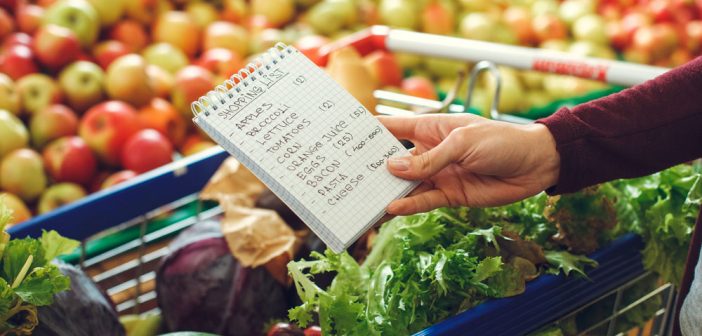Being able to eat healthy is something many of us aspire to do. It helps improve your energy and mood, and it also supports general health. However, when on a budget, it can be difficult to manage purchasing a variety of healthy foods without spending a large amount of money.
The good news is that, with some research, planning and strategics, you can easily eat a healthy diet for $10 a day or less. Here are some tips to help you get started.
1. Buy Fresh, Whole Foods
“Whole foods” are foods that haven’t been processed–fresh produce, eggs, and meat are some of the main examples. And while many people feel as though they can’t afford fresh fruits and vegetables, there are many very affordable choices. For instance, while kale is a much-talked-about superfood, collard greens are nutritionally similar and significantly less expensive. Bananas and potatoes are two additional examples of affordable fresh foods.
2. Find Inexpensive Lean Meats
Lean protein is one of the cornerstones of most healthy diets. But if you’ve ever approached a meat counter only to turn away because of pricing, you understand that finding affordable options can be tough.
If you’re willing to check the frozen section, many chain grocery stores offer very affordably priced frozen fish, including salmon and tilapia. You can buy these in bulk and store them in the freezer. Check for sales in the fresh meat sections too–chicken cutlets, lean ground beef, and ground turkey all frequently are offered on sale.
3. Don’t Forget Complex Carbohydrates
When you’re on a budget, the fiber content and nutritional value of whole grains and beans can help make meals more filling. These are also sources of sustained energy, and they can often be found very inexpensively. In particular, whole grain brown rice is sold very cheaply in stores. You can also buy quinoa, whole grain oats, and barley. While these items require some preparation at home, making them is fairly straightforward.
4. Plan Your Meals and Meal Prep
When you’re busy with school, work, or other commitments, it can be difficult to make time to cook. This makes it more likely that you’ll want to buy takeout or eat something fast. When you want to eat healthily and do so long-term, meal planning and prep is essential.
If you’ve ever been to the grocery store without a list, you may have undergone the common experience of purchasing a cart full of items that look good, only to realize you haven’t planned how to use any of them. In order to avoid this, plan out meals ahead of time and make a shopping list.
From there, you may want to try meal prep. To do so, you’ll need several resealable containers. Meal prepping allows you to make a large volume of food (usually enough for the week) and portion it out. That way, you have ready-to-go containers you can reheat and eat.
Of course, meal prepping for each meal may be too much, especially in the beginning. You may want to start with just meal prepping lunches. Since many people can cook breakfast before work and dinner after work, having a ready to go lunch saves you time and money during the workday.
5. Don’t Grocery Shop While Hungry
You’ve probably heard this advice before. And if you’ve ever grocery shopped while hungry, you may be among the countless people who have ended up spending more than they meant to on food they don’t need. Grocery shopping soon after you’ve had a nutritious meal will help you focus on finding healthy and affordable foods without cravings getting in the way.
And if you’re someone who struggles with cravings for unhealthy food, remember that healthy eating doesn’t require 24/7 willpower–you just need to be disciplined while purchasing food for the week. By exercising willpower in the store, you can ensure that you’ll have plenty of healthy options to choose from.
6. Keep Kitchen Essentials Stocked
There are few things more irritating than starting to cook a meal, only to realize that you’re out of an essential ingredient. By making sure you have necessary cooking oils, spices, and kitchen basics like flour, salt, and baking soda, you can ensure that you have common recipe components at the ready. That way, as you shop each week, you’ll just need to focus on fresh ingredients for your upcoming meals.
7. Commit to Cooking
Cooking at home often results in a healthier meal than you’ll find in a restaurant, and it also results in significant cost savings. If you need guidance or inspiration, you can find plenty of healthy recipes online. You also can find video tutorials, which are especially helpful if you don’t have a strong set of cooking skills and want to improve. Plus, as you get more comfortable cooking your own meals, you can improvise or create your own recipes.
8. Incorporate High-Volume, Low-Density Foods
Especially if you’re trying to keep calories low, adding in foods that are high in volume but low in caloric density will help you. One example is a simple chopped salad–it’s possible to make a large salad that’s both filling and low in calories. And if you’re on a very tight budget, iceberg lettuce provides an affordable option. You can add lean proteins, chopped vegetables, and even cheeses to turn a salad like this into a meal.
9. Don’t Forget Healthy Snacks
Healthy snack options can help you hold off any junk food cravings you have. Luckily, most stores have a wealth of affordable healthy snack foods to choose from:
- Cottage cheese
- Dried edamame
- Fresh fruit
- String cheese
- Greek yogurt
- Carrots
Especially if you’re relatively new to it, planning and preparing healthy meals while on a budget has a bit of a learning curve. But by following these tips, you’ll be able to eat healthy, even on a very tight budget.









